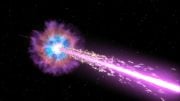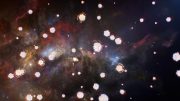
A visual impression of the data used in the study. The relevant extra-galactic maps are represented as shells of increasing distance from Earth from left to right. The closest thing seen is our Milky Way galaxy, which is a potential source of noise for the analysis. After this are six shells containing maps of the millions of distant galaxies used in the study. These maps are produced using different telescopes in different wavelengths and are color-coded to show denser clumps of galaxies as red and under-dense regions as blue. There are holes in the maps due to data quality cuts. The last, largest shell shows the temperature of the cosmic microwave background from the WMAP satellite (red is hot, blue is cold), which is the most distant image of the Universe seen, some 46 billion light-years away. The team has detected (at 99.996% significance) very small correlations between these foreground maps (on the left) and the cosmic microwave background (on the right). Credit: Earth: NASA/BlueEarth; Milky Way: ESO/S. Brunier; CMB: NASA/WMAP
After a two-year study, a team of astronomers at the University of Portsmouth and LMU University Munich have concluded that the likelihood of the existence of dark energy stands at 99.996 percent.
Dark energy, a mysterious substance thought to be speeding up the expansion of the Universe is really there, according to a team of astronomers at the University of Portsmouth and LMU University Munich. After a two-year study led by Tommaso Giannantonio and Robert Crittenden, the scientists conclude that the likelihood of its existence stands at 99.996 percent. Their findings are published in the journal Monthly Notices of the Royal Astronomical Society.
Professor Bob Nichol, a member of the Portsmouth team, said: “Dark energy is one of the great scientific mysteries of our time, so it isn’t surprising that so many researchers question its existence.
“But with our new work we’re more confident than ever that this exotic component of the Universe is real – even if we still have no idea what it consists of.”
Over a decade ago, astronomers observing the brightness of distant supernovae realized that the expansion of the Universe appeared to be accelerating. The acceleration is attributed to the repulsive force associated with dark energy now thought to make up 73 percent of the content of the cosmos. The researchers who made this discovery received the Nobel Prize for Physics in 2011, but the existence of dark energy remains a topic of hot debate.
Many other techniques have been used to confirm the reality of dark energy but they are either indirect probes of the accelerating Universe or susceptible to their own uncertainties. Clear evidence for dark energy comes from the Integrated Sachs Wolfe effect named after Rainer Sachs and Arthur Wolfe.
The Cosmic Microwave Background, the radiation of the residual heat of the Big Bang, is seen all over the sky. In 1967 Sachs and Wolfe proposed that light from this radiation would become slightly bluer as it passed through the gravitational fields of lumps of matter, an effect known as gravitational redshift.
In 1996, Robert Crittenden and Neil Turok, now at the Perimeter Institute in Canada, took this idea to the next level, suggesting that astronomers could look for these small changes in the energy of the light, or photons, by comparing the temperature of the radiation with maps of galaxies in the local Universe.
In the absence of dark energy, or a large curvature in the Universe, there would be no correspondence between these two maps (the distant cosmic microwave background and relatively closer distribution of galaxies), but the existence of dark energy would lead to the strange, counter-intuitive effect where the cosmic microwave background photons would gain energy as they traveled through large lumps of mass.
The Integrated Sachs Wolfe effect was first detected in 2003 and was immediately seen as corroborative evidence for dark energy, featuring in the ‘Discovery of the year’ in Science magazine. But the signal is weak as the expected correlation between maps is small and so some scientists suggested it was caused by other sources such as the dust in our galaxy. Since the first Integrated Sachs Wolfe papers, several astronomers have questioned the original detections of the effect and thus called some of the strongest evidence yet for dark energy into question.
In the new paper, the product of nearly two years of work, the team have re-examined all the arguments against the Integrated Sachs Wolfe detection as well as improving the maps used in the original work. In their painstaking analysis, they conclude that there is a 99.996 percent chance that dark energy is responsible for the hotter parts of the cosmic microwave background maps (or the same level of significance as the recent discovery of the Higgs boson).
“This work also tells us about possible modifications to Einstein’s theory of General Relativity”, notes Tommaso Giannantonio, lead author of the present study.
“The next generation of cosmic microwave background and galaxy surveys should provide the definitive measurement, either confirming general relativity, including dark energy, or even more intriguingly, demanding a completely new understanding of how gravity works.”
Reference: “The significance of the integrated Sachs-Wolfe effect revisited” by Tommaso Giannantonio, Robert Crittenden, Robert Nichol and Ashley J. Ross, 1 November 2012, Monthly Notices of the Royal Astronomical Society.
DOI: 10.1111/j.1365-2966.2012.21896.x









Technically they could be wrong. by.003 %, so its not actually a scientific FACT. Thanks for the info tho, Thanks for really helping with the economy and free energy. GJ (thumbs up)
It’s good that you expressed your opinion, Andy Hawkings
99.996 percent is the statistically important sigma value to confirm the existence just as they did on the Higgs Boson findings. When a billion findings are results of an experiment only the sigma value is important. We are not proving Archimedes Principle in a School Lab. In cosmos, the very hypothesis of Dark Energy and Dark Matter occupying 73 and 23 percent of all the avaibalbe energy leaving just 4 percent for the entire visible universe to be formed is itself an excellent discovery. It is not so easy to discard the Dark Matter hypothesis. Expanding Universe in a pareabolic way and driving of distant galaxies near the velocity of light by an unknown force has completely taken astronomers aback. Cosmic Microwaqve Backround being the residue of Doppler attenuation of original Cosmic Gamma Ray Backround speaks of galactic expansion. Gravitational lensing effect of distant galaxies is a proof of interwoven lumps of Dark Matter in between. Dark Matter has an anti-gravitational effect on neigboring galaxies and also splits light gravitationally from distant stars. Light which is the propery of 4 percent matter only of the visible universe can never pass through nor it can emanate from Dark Matter clouds. Dark Matter is perceived only by such gravitational effect. On the other hand 73 percent of Dark Energy is ombipotent in the cosmos spreading everywhere. Its density is undiminished and it is the reservoir of all the energy from the Big Bang, forgetting the trivial energy of our galaxies, stars and other light emitting , infra-red emitting and gamma ray emitting objects which are by itself a miniscule of the whole universe. Thank You.
Old news, but always interesting to read more on dark matter/energy.